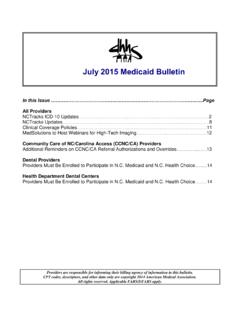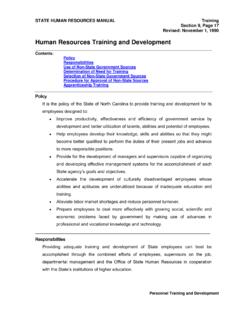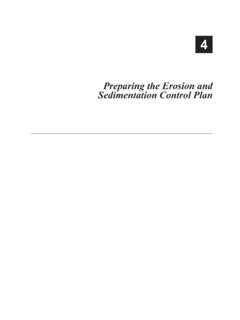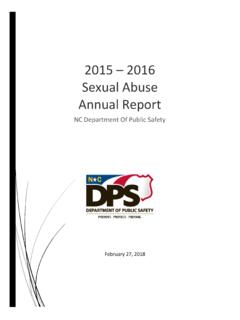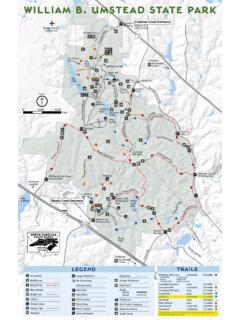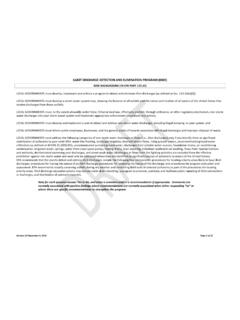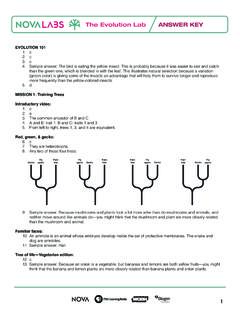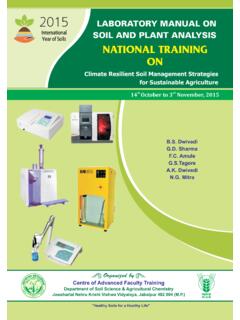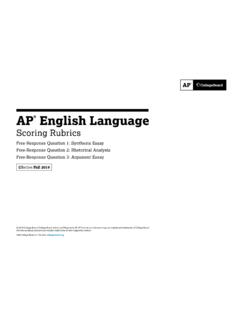Transcription of Bioretention Cell
1 NCDEQ Stormwater Design Manual C-2. Bioretention Cell Design Objective A Bioretention cell is an excavated area that is filled with a specialized soil media and plants , or grass/sod. It is designed to temporarily hold and filter stormwater. Bioretention cells are one of the most versatile SCMs: They can be installed in a variety of soil types from clay to sand and in a wide variety of sites. They are also one of the most effective SCMs for removing pollutants, because they use many different pollutant removal mechanisms, including infiltration, absorption, adsorption, evapotranspiration, microbial action, plant uptake, sedimentation, and filtration. Design Volume The design volume for a Bioretention cell is equivalent to the volume that is contained above the planting surface to the invert of the bypass mechanism for the design storm.
2 Important Links Rule 15A NCAC 2H .1052. MDC for Bioretention Cells SCM Credit Document, C-2. Credit for Bioretention Cells _____. C-2. Bioretention Cell 1 Revised: 1-19-2018. NCDEQ Stormwater Design Manual Table of Contents Guidance on the MDC. MDC 1: Separation from the SHWT. MDC 2: Maximum Ponding Depth for Design Volume MDC 3: Peak Attenuation Volume MDC 4: Underdrain MDC 5: Media Depth MDC 6: Media Mix MDC 7: Media P-Index MDC 8: No Mechanical Compaction MDC 9: Maintenance of Media MDC 10: Planting Plan MDC 11: Mulch MDC 12: Clean-out Pipes Recommendations Recommendation 1: Disperse Flow and Energy Recommendation 2: Pre-treatment Maintenance Comparison of Old Versus New Requirements Photo Gallery _____.
3 C-2. Bioretention Cell 2 Revised: 1-19-2018. NCDEQ Stormwater Design Manual Figure 1: Bioretention Example: Plan View _____. C-2. Bioretention Cell 3 Revised: 1-19-2018. NCDEQ Stormwater Design Manual Figure 2: Bioretention Example: Cross-Section _____. C-2. Bioretention Cell 4 Revised: 1-19-2018. NCDEQ Stormwater Design Manual Guidance on the MDC. Separ ati on from the SH WT. Bioretention MDC 1. SEPARATION FROM THE SHWT. The lowest point of the Bioretention cell shall be a minimum of two feet above the SHWT. However, the separation may be reduced to no less than one foot if the applicant provides a hydrogeologic evaluation prepared by a licensed professional. The calculation of the volume of the main pool under this MDC does not include the volume of the forebay.
4 The separation from the seasonal high water table is needed to ensure that the media does not become saturated and unable to function effectively. See Part A-2 for more information about conducting soil tests for SCMs. BIOR ET ENTION MDC 2: MAXIMUM POND ING DEPTH F OR D ESIGN VOLUME. Bioretention MDC 2: MAXIMUM PONDING DEPTH FOR DESIGN VOLUME. The maximum ponding depth for the design volume shall be 12 inches above the planting surface. This MDC is used to calculate the required surface area of the Bioretention cell, which is equal to the required treatment volume divided by the ponding depth. The ponding depth above the media and mulch shall be 12 inches or less (however 9 inches or less is recommended if the site will allow this much space to be devoted to the Bioretention cell).
5 The 12-inch limitation on depth is based on the typical inundation tolerance of the vegetation used in Bioretention facilities, as well as the ability of the ponded water to drain into the soil. BIOR ET ENTION MDC 3: PEAK ATT ENUAT ION VOLUM E. Bioretention MDC 3: PEAK ATTENUATION VOLUME. Bioretention cells may store peak attenuation volume at a depth of up to 24 inches above the planting surface. The peak attenuation outlet shall be a maximum of 18 inches above the planting surface. There is the option to design Bioretention cells to attenuate peak flows. If this is an objective of the design, then the overflow structure shall be sized to accommodate storm volumes in excess of the first flush. The first available outlet on the outlet structure should therefore be placed at the height of the first flush, which is the ponded level of the Bioretention cell.
6 Use the weir equation to consider the height of the water above the weir during overflow from large storm events. Stormwater is allowed to temporarily pond an additional 12 inches above the maximum ponding level for the design storm of 12 inches; however, the peak attenuation outlet shall not be more than 18 inches above the planting surface. A design storm is not specified for overflow structure design; that should be determined by the designer. The designer should also consider potential flooding risks outside of the Bioretention cell. BIOR ET ENTION MDC 4: UNDERDR AIN. Bioretention MDC 4: UNDERDRAIN. An underdrain with internal water storage shall be installed unless it is demonstrated that the in-situ soil infiltration rate is two inches per hour or greater immediately prior to the initial placement of the media.
7 The top of the internal water storage zone shall be set at a minimum of 18 inches below the planting surface. _____. C-2. Bioretention Cell 5 Revised: 1-19-2018. NCDEQ Stormwater Design Manual Underdrain sizing requirements are discussed in Part A-4. If the in-situ soil has a permeability of two inches per hour or greater, then an underdrain is not required because the stormwater will naturally infiltrate into the soil. Nearly all Bioretention cells in the Piedmont and western portions of NC will have underdrains. Per this MDC, an internal water storage zone is required for any Bioretention cell that has an underdrain system. An internal water storage zone (IWS) is created by adding an upturned elbow in the underdrain piping perpendicular to the horizontal underdrain.
8 Including an IWS. enhances the Bioretention cell's ability to attenuate peak flows, infiltrate stormwater, remove TSS and nitrogen, and cool stormwater. In fact, a Bioretention cell with an IWS will only rarely generate outflows in A and B soils. In Piedmont soils, the IWS remains saturated for a longer time, which creates anaerobic conditions that promote denitrification and increased N removal. In addition to their other benefits, Bioretention cells cool stormwater because stormwater is stored and discharged from underground. BIOR ET ENTION MDC 5: MED IA D EPTH. Bioretention MDC 5: MEDIA DEPTH. The minimum depth of the media depends on the design of the cell as follows: (a) all cells with trees and shrubs: 36 inches.
9 (b) cells without trees and shrubs: (i) with no internal water storage: 24 inches; or (iii) with internal water storage: 30 inches. The media depth of Bioretention cells that are planted with trees and shrubs shall be a minimum of 36 inches to accommodate the plant roots. Bioretention cells that are not planted with trees and shrubs ( , grass or herbaceous plants ) may have a shallower media depth, either 30. inches with an underdrain or 24 inches without an underdrain. Note that, per MDC 4, the only time that a Bioretention cell would not require an internal water storage zone is when the in-site soil infiltration rate is two inches per hour or greater. BIOR ET ENTION MDC 6: MED IA M IX. Bioretention MDC 6: MEDIA MIX.
10 The media shall be a homogeneous soil mix engineered media blend with approximate volumes of: (a) 75 to 85 percent medium to coarse washed sand (ASTM C33, AASHTO M 6/M 80, ASTM C330, AASHTO M195, or the equivalent);. (b) 8 to 15 percent fines (silt and clay); and (c) 5 to 10 percent organic matter (such as pine bark fines). It is very important to ensure that sand meets the specification above; sand particles that are too fine have caused clogging in several Bioretention cells across NC. Higher (8-10 percent) fines should be reserved for areas where TN is the target pollutant. In areas where phosphorus is the target pollutant, lower (5 to 8 percent) fines should be used. A fine' is defined as passing a #200 sieve.

